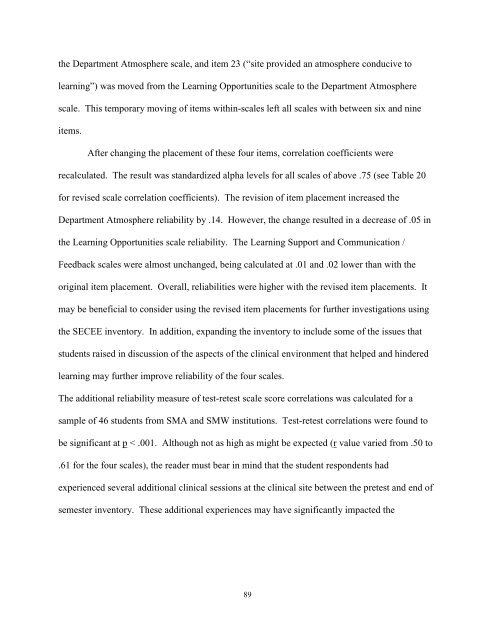STUDENT EVALUATION OF CLINICAL EDUCATION ENVIRONMENT
STUDENT EVALUATION OF CLINICAL EDUCATION ENVIRONMENT
STUDENT EVALUATION OF CLINICAL EDUCATION ENVIRONMENT
You also want an ePaper? Increase the reach of your titles
YUMPU automatically turns print PDFs into web optimized ePapers that Google loves.
the Department Atmosphere scale, and item 23 (“site provided an atmosphere conducive to<br />
learning”) was moved from the Learning Opportunities scale to the Department Atmosphere<br />
scale. This temporary moving of items within-scales left all scales with between six and nine<br />
items.<br />
After changing the placement of these four items, correlation coefficients were<br />
recalculated. The result was standardized alpha levels for all scales of above .75 (see Table 20<br />
for revised scale correlation coefficients). The revision of item placement increased the<br />
Department Atmosphere reliability by .14. However, the change resulted in a decrease of .05 in<br />
the Learning Opportunities scale reliability. The Learning Support and Communication /<br />
Feedback scales were almost unchanged, being calculated at .01 and .02 lower than with the<br />
original item placement. Overall, reliabilities were higher with the revised item placements. It<br />
may be beneficial to consider using the revised item placements for further investigations using<br />
the SECEE inventory. In addition, expanding the inventory to include some of the issues that<br />
students raised in discussion of the aspects of the clinical environment that helped and hindered<br />
learning may further improve reliability of the four scales.<br />
The additional reliability measure of test-retest scale score correlations was calculated for a<br />
sample of 46 students from SMA and SMW institutions. Test-retest correlations were found to<br />
be significant at p < .001. Although not as high as might be expected (r value varied from .50 to<br />
.61 for the four scales), the reader must bear in mind that the student respondents had<br />
experienced several additional clinical sessions at the clinical site between the pretest and end of<br />
semester inventory. These additional experiences may have significantly impacted the<br />
89












